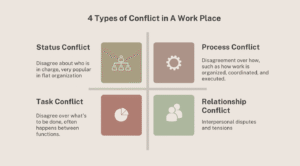Let’s be real—workplace conflict happens. Differing opinions, competing priorities, and misunderstandings are inevitable when people collaborate. But while clashes can feel uncomfortable, they aren’t inherently bad. In fact, when managed appropriately, conflict can generate improved ideas, enhanced relationships, and actual growth. The key isn’t avoiding disagreements—it’s learning to navigate them constructively. When we approach conflict with curiosity instead of fear, we turn tension into opportunity.
“Conflict is not the enemy—avoidance is. Organizations that embrace healthy conflict resolution don’t just survive; they innovate, adapt, and thrive.”

Understanding Workplace Conflict
Conflict arises from perceived incompatibilities between individuals or groups. Common sources include:
- Communication Breakdowns – Misunderstandings, unclear expectations, or poor listening.
- Personality Clashes – Differences in work styles, values, or temperaments.
- Competition for Resources – Limited budgets, promotions, or recognition.
- Role Ambiguity – Unclear job responsibilities leading to friction.
Common Types of Conflict
- Status Conflict: Struggles over perceived rank, recognition, or influence.
Causes:
- Unclear decision-making authority
- Competition for promotions/credit
- Threatened professional Status
Example:
Two team members both start giving instructions during a meeting. One feels they are leading the project, while the other believes the leadership wasn’t formally assigned.
- Task Conflict: Disagreements about what work to do or how to accomplish goals.
Causes:
- Differing professional opinions
- Competing approaches to problem-solving
- Varying interpretations of success criteria
Example:
The marketing team believes the next campaign should focus on social media, while the sales team insists it should be an email campaign.
- Process Conflict: Clashes over work methods, workflows, or resource allocation.
Causes:
- Competing preferences for tools/systems
- Unclear role responsibilities
- Time management disagreements
Example:
One team member wants to handle customer complaints by phone, while another insists emails are more professional.
- Relationship Conflict: Personal friction between individuals.
Causes:
- Personality/value clashes
- Poor communication styles
- Unresolved past tensions
Example:
Two team members had a disagreement outside of work, and that tension begins to affect their collaboration. During a team discussion, one of them makes a sarcastic remark or overlook the other’s input, creating discomfort and disrupting the flow of communication.

Conflict Resolution Strategies
Different situations require different approaches. Here are five key conflict resolution strategies:
- Collaborative Problem-Solving (Win-Win Approach)
- Involves open discussion to find a mutually beneficial solution.
- Encourages teamwork, trust, and long-term relationship building.
- Best for complex conflicts where both parties’ input is valuable.
- Compromise (Give-and-Take Approach)
- Both parties make concessions to reach a middle ground.
- Useful when time is limited or complete agreement is difficult
- Example: Negotiating work schedules to accommodate both employees.
- Avoidance (Delaying or Ignoring Conflict)
- Temporarily stepping back to prevent escalation.
- Effective for minor issues or when emotions are high.
- Accommodation (Yielding to Others’ Needs)
- One party prioritizes harmony over personal goals.
- Useful when maintaining relationships is more important than winning an argument.
- Example: Agreeing to a colleague’s suggestion to avoid tension.
- Assertive Resolution (Standing Firm Respectfully)
- Clearly expressing needs while respecting others.
- Helps in setting boundaries without aggression.
- Example: A manager addressing performance issues directly but professionally.
Steps to Resolve Conflicts Effectively
- Identify the Issue– Clearly define the problem without blame.
- Listen Actively– Allow all parties to express their viewpoints.
- Find Common Ground– Look for shared interests or goals.
- Brainstorm Solutions– Encourage collaborative problem-solving.
- Agree on Action Steps– Decide on a fair resolution and follow up.
Conclusion: Conflict Is Your Team’s Hidden Catalyst
Workplace conflict isn’t a sign of failure—it’s a sign of diverse perspectives colliding with potential. By understanding the roots of tension (status, task, process, or relationship conflicts) and choosing the right resolution strategy, you can turn friction into innovation, trust, and progress.
Remember:
- Curiosity over fear – Approach disagreements as opportunities to learn.
- Collaboration over avoidance – The best solutions often lie in merging viewpoints.
- Action over stagnation – Use the steps outlined here to resolve conflicts before they fester.
The goal isn’t a conflict-free workplace (an unrealistic fantasy), but a resilient one—where tensions are harnessed to fuel creativity, clarity, and stronger teams.
So, Next time you find yourself in a workplace disagreement, try seeing it as an opportunity rather than a threat. With patience, empathy and good communication, what starts as tension can become your team’s breakthrough moment. After all, we’re all human – imperfect, emotional, and doing our best. When we approach conflicts with that understanding, we don’t just resolve issues; we build workplaces where people truly want to be.





Leave a Reply